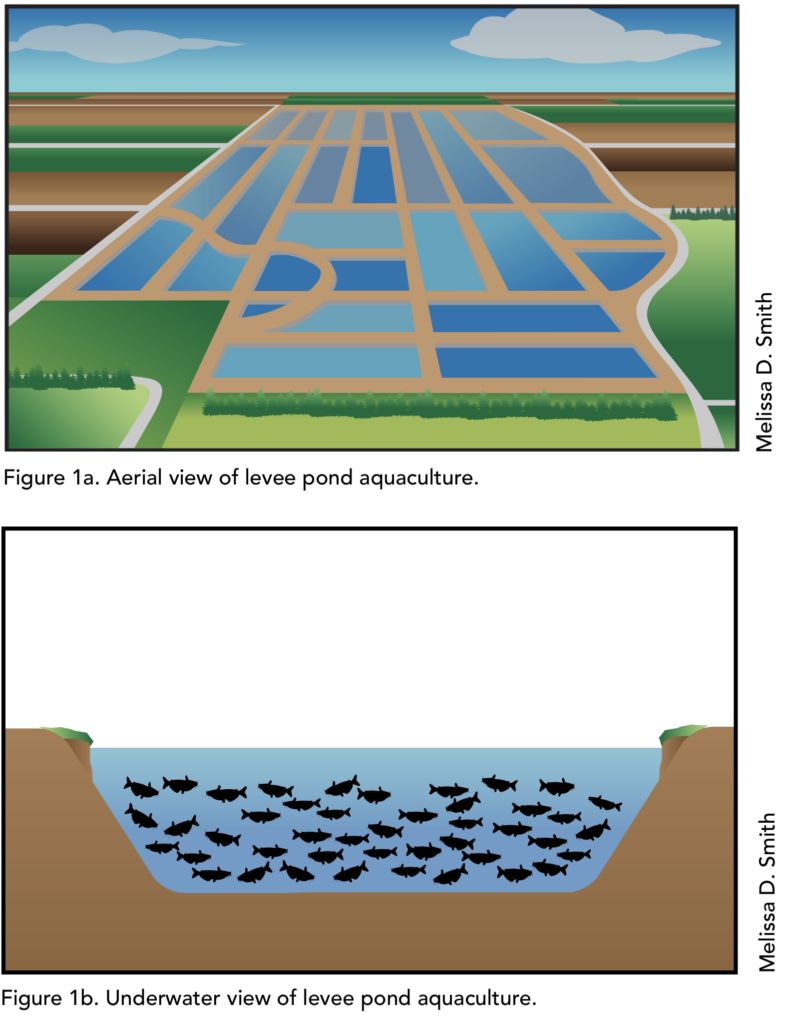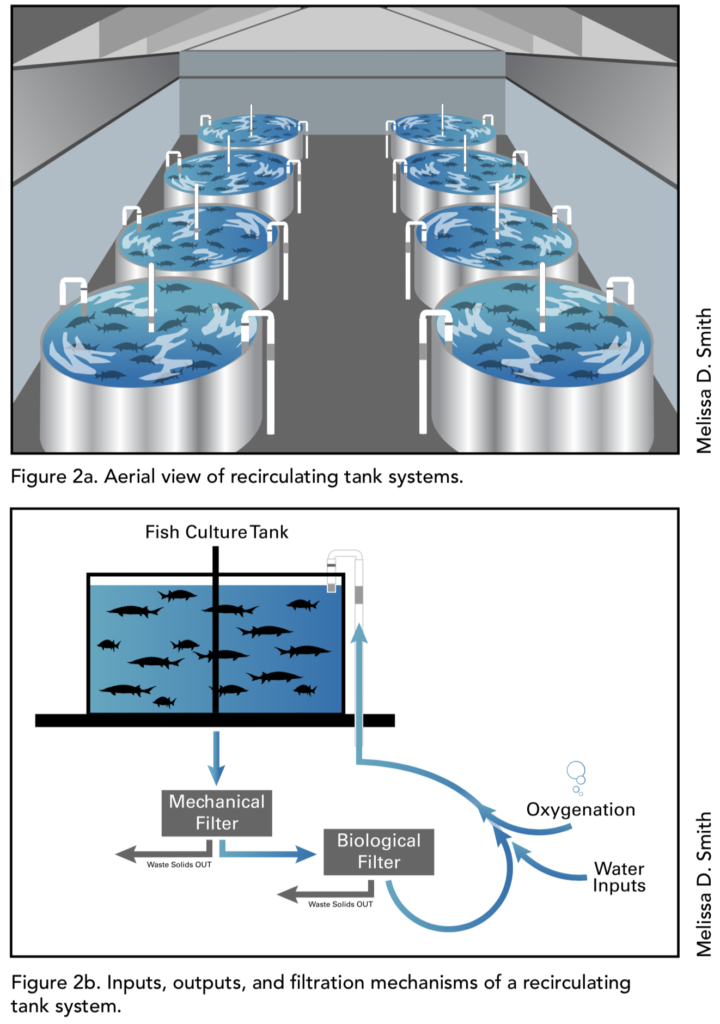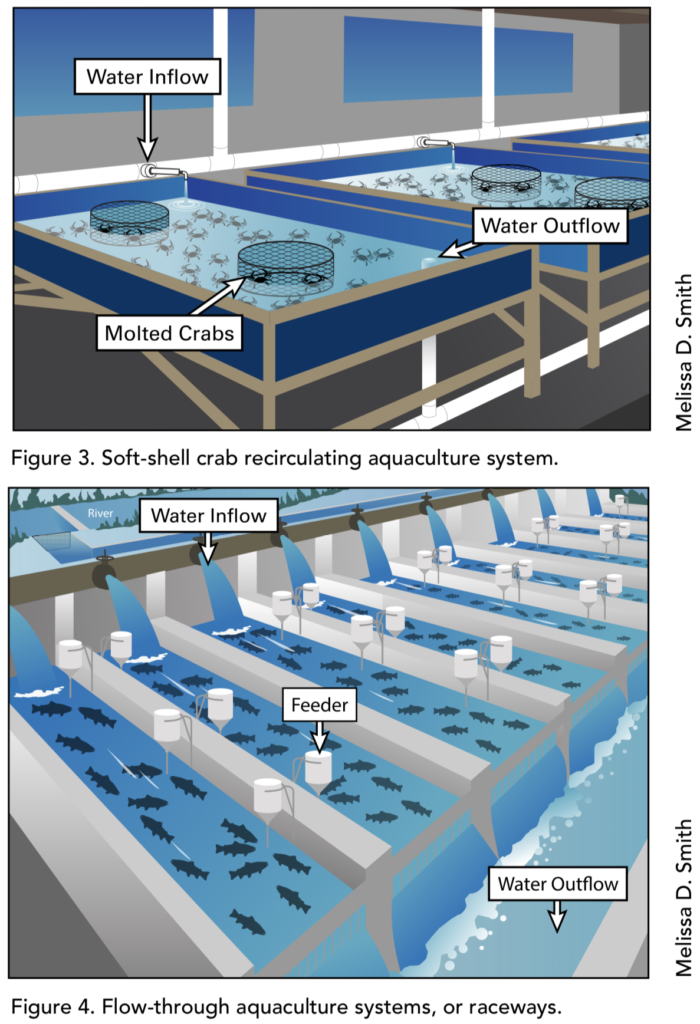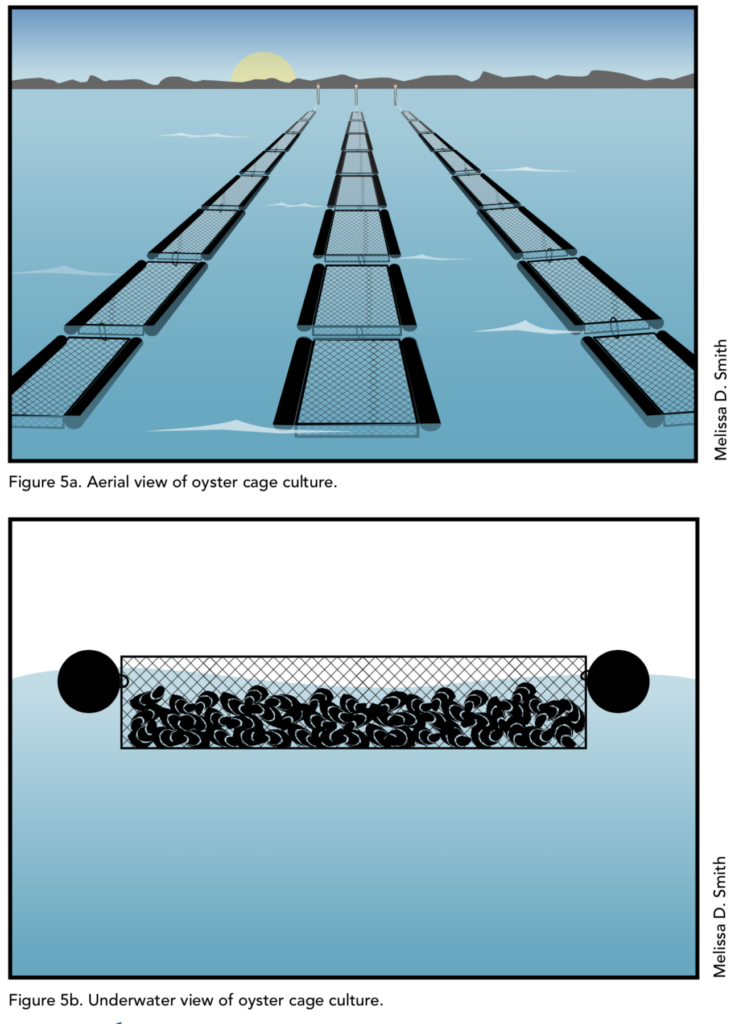Lesson 5: Aquaculture Production Methods and Policy
Objectives
By the end of this lesson, students will be able to:
- Characterize aquaculture production methods, including:
- Technology and material needs
- Ideal location
- Appropriate species for culturing
- Benefits and drawbacks
- Summarize national, state and local laws and regulations that determine which aquaculture production methods are permissible.
Overview
There are a variety of aquaculture production methods that suit different species and water bodies. Some aquaculture techniques are even used on land! Aquaculture systems can employ pens, cages, stakes, ropes and rafts in open water environments and tanks in indoor systems. In this lesson, students will explore aquaculture production methods and consider which species are most suitable for a particular type of technology. They also will research the laws and regulations that determine which production methods are permissible.
Career and Technical Education Standards: Relevant to agricultural education courses
Grade Level: 11-12
Duration: 2 class periods
Science Standards
EEn.2.2.1
- Explain the need for and consequences of various types of land use, such as urbanization, deforestation and agriculture.
- Explain ways to mitigate detrimental human impacts on the lithosphere and maximize sustainable use of natural resources.
Vocabulary
best management practices: activities that are effective at achieving a desired impact (e.g., environmental sustainability, operation efficiency)
culling: selective reduction of an animal population
intensive culture: aquaculture technology that produces species at high densities and yields, and that requires more inputs and higher start-up costs than other forms of aquaculture
extensive culture: aquaculture technology that produces species at low densities and yields, and that requires fewer inputs and lower start-up costs than other forms of aquaculture
mariculture: cultivation of the living resources of the marine environment, including marine finfish, shellfish and plants
Background
Technology to grow aquatic plants and animals has evolved from natural systems like ponds to human-engineered systems, such as net pens in the ocean and aquarium-like tanks on land. Aquaculture systems vary greatly with respect to species cultured, profitability and environmental impacts. Improvements in aquaculture technology have led to more efficient growing methods, allowing growers to make more product at lower costs. What follows is a brief description of five common aquaculture production methods.
Pond Aquaculture
For successful pond production, ponds must be properly sited and built, with careful assessment of water availability, quantity and quality. There are two main types of pond systems: watershed and levee. Watershed ponds are generally built in hilly areas by damming a small stream. A levee pond is built by removing soil from an area so that the depression can become the pond bottom. The removed soil is used to form levees, or embankments, around the pond perimeter.
Areas that have enough rainfall to fill ponds — and keep them filled — will be better suited to watershed pond systems. In an area where the main water source is groundwater, then a levee pond may be more suitable. The majority of aquaculture production ponds in the United States are levee ponds. For example, catfish production in the southeastern U.S. often relies on a levee pond system.

Recirculating Systems
Traditional pond aquaculture requires large quantities of water and may not be possible in areas with limited water supply or land for pond construction. Alternatively, recirculating systems use a fraction of the water required by ponds to produce similar yields. In addition, recirculating systems allow the producer to maintain appropriate salinity and temperature and avoid diseases present in the wild. In these systems, above-ground tanks are used, requiring substantially less land. The water in recirculating tank systems is treated and reused through biological and mechanical filtration.
The capital costs, or start-up investment, of recirculating systems are often prohibitive. These systems also increase operation costs due to their high energy needs. Recirculating systems are more likely to be profitable with a high-value fish. For example, Marshallberg Farm in Carteret County, North Carolina, produces sturgeon in these systems for the lucrative caviar market. Soft-shell crabs are also produced in recirculating aquaculture systems.

Recirculating Systems – Soft-Shell Crab Aquaculture: Soft-shell crabs can be produced in indoor or outdoor recirculating aquaculture systems, such as the shallow tanks depicted here. These shedding tanks are simple troughs or shallow tables used to hold running water that is pumped from a brackish water supply. Water filtration maintains proper water quality. Molting crabs are separated by mesh enclosures to protect them during this vulnerable life stage.

Raceways
Flow-through aquaculture systems, called raceways, are those in which water is pumped through relatively shallow, above-ground tanks. Water passes through the systems once, providing waste treatment, and then the water is discharged. Raceways are commonly located outdoors near rivers, streams, springs or artesian wells so that water can be diverted and flowed through the farm by gravity. Per unit of space, production is higher for raceways than ponds, and raceways also make it easier to observe the fish. A key constraint of these systems, however, is the need for a large, constant flow of high-quality water. Raceways are commonly used to culture rainbow trout.
Oyster Cage Culture
A cage confines fish or shellfish in a mesh enclosure located in an existing water body, such as a pond, river, estuary or the open ocean. Restricted to their cages, organisms are easy to feed, observe and harvest. The mesh allows water to pass freely between the organism and surrounding waters. As a result, waste is removed and water quality maintained for the cultured organism. New material technology for cage construction has lowered production costs and enhanced production efficiency over time. Simple forms of cage culture, such as floating cages or bags used by oyster growers, generally have a lower initial financial investment than pond aquaculture. Oysters are commonly grown in floating cages in estuaries and the nearshore ocean.

Marine Finfish Net Pen Culture
Marine finfish net pen culture is a type of cage culture that confines fish in a mesh enclosure and relies on existing water resources, specifically marine waters. The effect of waste discharge and siting decisions on marine water quality and habitat are important environmental considerations. Costs can be high to establish marine finfish net pen farms in the U.S., because stringent regulations are put in place to mitigate environmental problems. Salmon are commonly grown with marine net pen culture.


Activity
- Materials
- Download the aquaculture production methods PowerPoint presentation
- Download and print the Student Worksheet
- View the “flapbook” example
PART 1
First, the teacher will share the aquaculture production methods PowerPoint presentation. Next, students will choose three aquaculture production methods to research.
Students should use the worksheet to answer the following questions:
- Does the method generally rely on fresh or salt water?
- Is the method used on land or in water? If it’s used in water, to what type of water bodies is it well suited (e.g., freshwater ponds, rivers, near- shore ocean, open ocean)? Are there limitations to where the method can be located?
- Is the method a form of extensive, semi-intensive or intensive aquaculture?
- What physical materials or equipment are required?
- What species are commonly raised through this method?
- What are the potential environmental impacts of the method?
- How are nutrients, such as excessive feed and fish waste, managed with this method?
- What are the benefits of this method? What about drawbacks?
- Are there any best management practices that should be used with this method? If so, describe them.
- Is the method suitable for aquaculture in North Carolina? Why or why not?
Students will create a “flapbook” (see example) that illustrates their knowledge of the three aquaculture production methods they chose.
A flapbook features informational windows, or flaps, that open to more information. Students’ flapbooks should include illustrations of each aquaculture production method. They can use the flapbook template provided in the worksheet or create their own. Note that the template provided includes more than three production methods.
Students can use the following resources to start their research:
- Fact Sheets – Important Species Produced in the Southern Region, Including Production Methods [Southern Regional Aquaculture Center]
- Website – Aquaculture Methods and Practices [Food and Agriculture Organization of the United Nations]
- Article – Farming Clams [TheKitchn]
- Website – Aquaculture Methods [SeaChoice]
- Report – Best Management Practices [Gulf and Caribbean Fisheries Institute]
- Video (0:42) How Seafood Is Farmed: Tanks [Monterey Bay Aquarium’s Seafood Watch]
- Video (1:09) How Seafood Is Farmed: Ponds [Monterey Bay Aquarium’s Seafood Watch]
- Video (1:34) How Seafood Is Farmed: Open Net Pens [Monterey Bay Aquarium’s Seafood Watch]
- Video (6:21) New Way to Grow Oysters [NC Farm Bureau]
PART 2
Students will review several sources on N.C. and U.S. aquaculture laws and regulations to determine which production methods are permissible in the state.
Possible Readings:
- Permitting Aquaculture Facilities in North Carolina, N.C. Department of Agriculture and Consumer Services
- Regulation of Aquaculture in the United States, University of Arkansas
- Looking to the Future of Oyster Aquaculture, North Carolina Sea Grant
Students will be divided into four groups: (1) entrepreneurs, (2) policymakers, (3) coastal town residents and (4) environmental organization members. Each group will choose an aquaculture species to focus on (e.g., channel catfish, sturgeon, soft-shell blue crab, rainbow trout, Eastern oyster, Atlantic salmon). Then they will read the designated scenario and answer the questions below. Each group will present their answers on a group poster or whiteboard to the class.
Scenarios:
- Entrepreneurs: You have been loaned $100,000 to start an aquaculture farm in North Carolina. Where will you locate your farm and why? Be specific. Are there any laws or regulations that may keep you from being successful? Are there any that will help you?
- Policymakers: An aquaculture farm is being constructed in the region in North Carolina that you represent. What questions about the business would you ask? Are there any existing regulations that will affect the farm? What possible regulations will you enact — or end — that would affect its business?
- Coastal town residents: A mariculture farm is being constructed in your town in North Carolina. What questions and concerns do you have? Are there any regulations that policymakers should consider enacting or ending that would affect this business?
- Environmental organization members: An aquaculture farm is being constructed in your area of North Carolina. What questions and concerns do you have? Are there any regulations that policymakers should consider enacting or ending that would affect this business?
Extension
- Students will identify how wastes like nitrogen from various marine aquaculture production systems are processed.
- Students will compare the processing of nutrients (e.g., excessive fish food and fish waste) in a specific type of mariculture operation with processing at a wastewater treatment plant. Are the same nutrients of concern to both? How do waste-processing technologies differ between mariculture operations and the plant?
